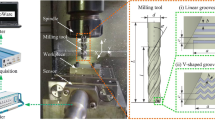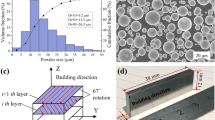Abstract
The anisotropy, inhomogeneity, high brittleness, and hardness of Al-50wt% Si alloy challenge its machinability in conventional processing. To solve the problem of serious machined surface defects on the groove bottom, the longitudinal ultrasonic vibration–assisted milling (LUVAM) technique was developed for Al-50wt% Si alloy groove machining. Based on the characteristics of tool-workpiece separation and frictional reversal, the variation of cutting force and cutting temperature with amplitude was studied. The influence of amplitude on the material removal mechanism and surface formation characteristics of Al-50wt% Si alloy groove bottom under different material removal rates (precision and non-precision milling (PM and NPM)) were the focus of this paper. The results show that the probability of Si particle breakage and spalling in PM decreases with the increase of amplitude, and the particles are sheared instead. The ultrasonic dressing effect reduces the anisotropy of Al-50wt% Si alloy. However, in NPM, the ultrasonic dressing effect weakens and the dynamic impact effect increases when the amplitude exceeds the critical value 2.5 μm. Additionally, the groove bottom surface features are related to the down milling (DM) and up milling (UM) methods. UM is the better method for PM of Al-50wt% Si alloy, and DM is the better method for NPM of Al-50wt% Si alloy. This work suggests that under different material removal rates, the machined groove quality of Al-50wt% Si alloy can be improved by selection of optimized amplitude in LUVAM.















Similar content being viewed by others
Data availability
The data and material in this paper are original, available, and objective.
Code availability
Not applicable.
References
Zhang W, Ding D, Gao P (2016) High volume fraction Si particle-reinforced aluminium matrix composites fabricated by a filtration squeeze casting route. Mater Des 90:834–838. https://doi.org/10.1016/j.matdes.2015.11.033
Wang S, Fu M, Li X, Wang J, Su X (2018) Microstructure and mechanical properties of Al-Si eutectic alloy modified with Al-3P master alloy. J Mater Process Technol 255:105–109. https://doi.org/10.1016/j.jmatprotec.2017.12.008
Niu QL, Li S, Chen YN, Li CP, Li SJ, Ko TJ, Li PN, Chen M, Qiu XY (2022) A constitutive model of Al/50wt%Sip composites considering particle damage effects. Mater Sci Eng A Struct 836:142726. https://doi.org/10.1016/j.msea.2022.142726
Cai ZG, Wang RC, Zhang C, Peng CQ, Yan F, Wang LQ (2015) Thermal cycling reliability of Al/50Sip composite for thermal management in electronic packaging. J Mater Sci Mater Electron 26:4894–4901. https://doi.org/10.1007/s10854-015-2999-y
Cai ZY, Zhang C, Wang RC, Peng CQ, Wu X, Li HP (2018) High-temperature mechanical properties and thermal cycling stability of Al-50Si alloy for electronic packaging. Mater Sci Eng A Struct 728:95–101. https://doi.org/10.1016/j.msea.2018.05.020
Cai ZY, Zhang C, Wang RC, Peng CQ, Wu X, Li HP (2018) Microstructure, mechanical and thermo-physical properties of Al-50Si-xMg alloys. Mater Sci Eng A Struct 730:57–65. https://doi.org/10.1016/j.msea.2018.05.098
Jia QJ, Liu JY, Yan-Xia LI, Wang WS (2013) Microstructure and properties of electronic packaging box with high silicon aluminum-base alloy by semi-solid thixoforming. Trans Nonferr Metal Soc 23:80–85. https://doi.org/10.1016/S1003-6326(13)62432-2
Jcw A, Sc A, Tjk A, Ms B, Atc B (2019) Influence of contact area on the sliding friction and wear behaviour of an electrochemical jet textured Al-Si alloy. Wear 426–427:1336–1344. https://doi.org/10.1016/j.wear.2019.01.008
Zhou Y, Sun H, Li A, Lv M, Zhao J (2019) FEM simulation based cutting parameters optimization in machining aluminum-silicon piston alloy ZL109 with PCD tool. J Mech Sci Technol 33:3457–3465. https://doi.org/10.1007/s12206-019-0640-3
Jing L, Niu QL, Zhan D, Li SJ, Yue WH (2023) Predictive modeling of surface roughness and feed force in Al-50wt% Si alloy milling based on response surface method and various optimal algorithms. Arab J Sci Eng 48:3209–3225. https://doi.org/10.1007/s13369-022-07114-8
Niu Z, Cheng K (2020) Improved dynamic cutting force modelling in micro milling of metal matrix composites Part I: theoretical model and simulations. Proc Inst Mech Eng C-J Mech Eng Sci 234:1733–1745. https://doi.org/10.1177/0954406219899688
Gao H, Ma B, Zhu Y, Yang H (2022) Enhancement of machinability and surface quality of Ti-6Al-4V by longitudinal ultrasonic vibration-assisted milling under dry conditions. Measurement 187:110324. https://doi.org/10.1016/j.measurement.2021.110324
Xie Z, Liu Z, Wang B, Xin M, Song Q, Jiang L (2021) Longitudinal amplitude effect on material removal mechanism of ultrasonic vibration-assisted milling 2.5D C/SiC composites. Ceram Int 47:32144–32152. https://doi.org/10.1016/j.ceramint.2021.08.106
Zhang J, Yuan H, Feng L, Zhang J, Chen X, Xiao J, Xu J (2023) Enhanced machinability of Ni-based single crystal superalloy by vibration-assisted diamond cutting. Precis Eng 79:300–309. https://doi.org/10.1016/j.precisioneng.2022.11.012
Zhou J, Lu M, Lin J, Zhou X, Guo M, Du Y (2022) Investigation of surface integrity transition of SiCp/Al composites based on specific cutting energy during ultrasonic elliptical vibration assisted cutting. J Manuf Process 79:654–665. https://doi.org/10.1016/j.jmapro.2022.04.067
Bai YH, Shi ZQ, Lee YJ, Wang H (2020) Optical surface generation on additively manufactured AlSiMg0.75 alloys with ultrasonic vibration assisted machining. J Mater Process Technol 280:116597. https://doi.org/10.1016/j.jmatprotec.2020.116597
Zha H, Feng P, Zhang J, Yu D, Wu Z (2018) Material removal mechanism in rotary ultrasonic machining of high-volume fraction SiCp/Al composites. Int J Adv Manuf Technol 97:1–11. https://doi.org/10.1007/s00170-018-2075-x
Zhou L, Zhou M, Han X, Zhou J (2019) 3D surface roughness evaluation of surface topography in ultrasonic vibration assisted end grinding of SiCp/Al composites. Int J Nanomanuf 15:290–303. https://doi.org/10.1504/IJNM.2019.100462
Kadivar MA, Akbari J, Yousefi R, Rahi A, Nick MG (2014) Investigating the effects of vibration method on ultrasonic-assisted drilling of Al/SiCp metal matrix composites. Robot Comput Integr Manuf 30:344–350. https://doi.org/10.1016/j.rcim.2013.10.001
Zhou J, Lu M, Lin J, Du Y (2021) Elliptic vibration assisted cutting of metal matrix composite reinforced by silicon carbide: an investigation of machining mechanisms and surface integrity. J Mater Res Technol 15:1115–1129. https://doi.org/10.1016/j.jmrt.2021.08.096
Nestler A, Schubert A (2014) Surface properties in ultrasonic vibration assisted turning of particle reinforced aluminium matrix composites. Procedia CIRP 13:125–130. https://doi.org/10.1016/j.procir.2014.04.022
Cao Y, Ding W, Zhao B, Wen X, Li S, Wang J (2022) Effect of intermittent cutting behavior on the ultrasonic vibration-assisted grinding performance of Inconel718 nickel-based superalloy. Precis Eng 78:248–260. https://doi.org/10.1016/j.precisioneng.2022.08.006
Liu JJ, Jiang XG, Gao Z, Zhang ML, Zhang DY (2019) Investigation of the effect of vibration amplitude on the surface integrity in high-speed rotary ultrasonic elliptical machining for side milling of Ti-6Al-4V. Chin J Mech Eng 55:215–223. https://doi.org/10.3901/JME.2019.11.215
Xiang D, Li B, Peng P, Shi Z, Li Y, Gao G, Zhao B (2022) Study on formation mechanism of edge defects of high-volume fraction SiCp/Al composites by longitudinal-torsional ultrasonic vibration-assisted milling. Proc Inst Mech Eng C-J Mech Eng Sci 236:6219–6231. https://doi.org/10.1177/09544062211065634
Li XZ, Dai B, Xu JK, Tong L, Wang M, Wang S (2021) Study on the influence of amplitude on ultrasonic assisted grinding of hard and brittle materials. Mater Sci Forum 1047:57–61. https://doi.org/10.4028/www.scientific.net/MSF.1047.57
Li Y, Xiang D, Feng H, Gao G, Shi Z (2020) Surface characteristics investigation of ultrasonic longitudinal-torsional milling of high-volume fraction SiCp/Al. Int J Adv Manuf Technol 110:2119–2130. https://doi.org/10.1007/s00170-020-05971-x
Rinck PM, Gueray A, Kleinwort R, Zaeh MF (2020) Experimental investigations on longitudinal-torsional vibration-assisted milling of Ti-6Al-4V. Int J Adv Manuf Technol 108:3607–3618. https://doi.org/10.1007/s00170-020-05392-w
Maurotto A, Wickramarachchi CT (2016) Experimental investigations on effects of frequency in ultrasonically-assisted end-milling of AISI 316L: a feasibility study. Ultrasonics 65:113–120. https://doi.org/10.1016/j.ultras.2015.10.012
Wang JS, Fu JG, Wang JL, Du FM, Liew PJ, Shimada K (2020) Processing capabilities of micro ultrasonic machining for hard and brittle materials: SPH analysis and experimental verification. Precis Eng 63:159–169. https://doi.org/10.1016/j.precisioneng.2020.02.008
Tsai MY, Chang CT, Ho JK (2016) The machining of hard mold steel by ultrasonic assisted end milling. Appl Sci 6:373. https://doi.org/10.3390/app6110373
Namlu RH, Sadigh BL, Kiliç SE (2021) An experimental investigation on the effects of combined application of ultrasonic assisted milling (UAM) and minimum quantity lubrication (MQL) on cutting forces and surface roughness of Ti-6Al-4V. Mach Sci Technol 25. https://doi.org/10.1080/10910344.2021.1971706
Xiong Y, Wang W, Jiang R, Lin K (2018) Analytical model of workpiece temperature in end milling in-situ TiB2/7050Al metal matrix composites. Int J Mech Sci 149:285–297. https://doi.org/10.1016/j.ijmecsci.2018.10.008
Zhou H, Cui H, Qin QH (2018) Influence of ultrasonic vibration on the plasticity of metals during compression process. J Mater Process Technol 251:146–159. https://doi.org/10.1016/j.jmatprotec.2017.08.021
Siddiq A, Sayed TE (2012) A thermomechanical crystal plasticity constitutive model for ultrasonic consolidation. Comput Mater Sci 51:241–251. https://doi.org/10.1016/j.commatsci.2011.07.023
Littmann W, Storck H, Wallaschek J (2001) Sliding friction in the presence of ultrasonic oscillations: superposition of longitudinal oscillations. Arch Appl Mech 71:549–554. https://doi.org/10.1007/s004190100160
Storck H, Littmann W, Wallaschek J, Mracek M (2002) The effect of friction reduction in presence of ultrasonic vibrations and its relevance to travelling wave ultrasonic motors. Ultrasonics 40:379–383. https://doi.org/10.1016/S0041-624X(02)00126-9
Liu J, Chen G, Ren C, Qin X, Ge J (2020) Effects of axial and longitudinal-torsional vibration on fiber removal in ultrasonic vibration helical milling of CFRP composites. J Manuf Process 58:868–883. https://doi.org/10.1016/j.jmapro.2020.08.071
Yang X, Zhang B (2019) Material embrittlement in high strain-rate loading. Int J Extreme Manuf 1:022003. https://doi.org/10.1088/2631-7990/ab263f
Dotcheva M, Dotchev K, Popov I (2013) Modelling and optimisation of up-and down-milling processes for a representative pocket feature. Int J Precis Eng Manuf 14:703–708. https://doi.org/10.1007/s12541-013-0094-y
Funding
This work is financially supported by the National Natural Science Foundation of China (nos. 52075168, 52275424), the Project of Department of Education of Hunan Province (no. 22A0331), and the Hunan Postgraduate Research Innovation Project Fund (no. CX20221051).
Author information
Authors and Affiliations
Contributions
Lu Jing: conceptualization, methodology, investigation, data collection and analysis, writing — original draft. Qiulin Niu: conceptualization, methodology, funding acquisition, writing — review and editing. Wenhui Yue: conceptualization, writing — review and editing, supervision. Jie Rong: investigation, methodology. Hang Gao: methodology. Siwen Tang: supervision, funding acquisition.
Corresponding authors
Ethics declarations
Ethics approval
Not applicable.
Consent to participate
Not applicable.
Consent for publication
We would like to submit the manuscript entitled “Groove bottom material removal mechanism and machinability evaluation for longitudinal ultrasonic vibration–assisted milling of Al-50wt% Si alloy” by Lu Jing, Qiulin Niu, Wenhui Yue, Jie Rong, Hang Gao, and Siwen Tang, and we wish to be considered for publication in the International Journal of Advanced Manufacturing Technology.
Conflict of interest
The authors declare no competing interests.
Additional information
Publisher's note
Springer Nature remains neutral with regard to jurisdictional claims in published maps and institutional affiliations.
Rights and permissions
Springer Nature or its licensor (e.g. a society or other partner) holds exclusive rights to this article under a publishing agreement with the author(s) or other rightsholder(s); author self-archiving of the accepted manuscript version of this article is solely governed by the terms of such publishing agreement and applicable law.
About this article
Cite this article
Jing, L., Niu, Q., Yue, W. et al. Groove bottom material removal mechanism and machinability evaluation for longitudinal ultrasonic vibration–assisted milling of Al-50wt% Si alloy. Int J Adv Manuf Technol 127, 365–380 (2023). https://doi.org/10.1007/s00170-023-11548-1
Received:
Accepted:
Published:
Issue Date:
DOI: https://doi.org/10.1007/s00170-023-11548-1




